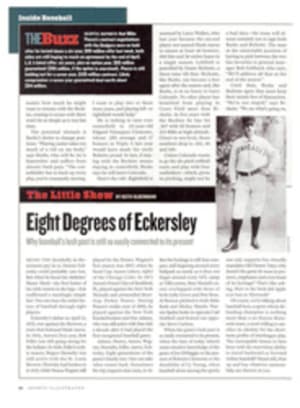
Bittersweet Race In The Desert The Bataan Memorial Death March honors fallen warriors
The Bataan Death March, which took place on the Philippine
island of Luzon 56 years ago this month, was perhaps the
greatest atrocity ever inflicted on U.S. soldiers. After
surrendering to the invading forces of Japanese General Masharu
Homma, some 15,000 Americans, starving, shell-shocked and
ravaged by tropical diseases, were forced to march 65 miles
through miasmal jungles to camps in the north of Luzon. Along
the way, 10,000 soldiers died from water deprivation or
dysentery or were executed by their Japanese captors. Since
then, the phrase "Bataan Death March" has been used to describe
any experience that is unimaginably toilsome and draining. But
the details of the original march, and the profound suffering of
those who were subjected to it, have largely receded from
memory. Which is why, a little more than a decade ago, an ROTC
cadet from New Mexico named Ray Pickering decided to create a
footrace to honor the victims of Bataan. On April 19 the White
Sands (N.M.) Missile Range will be the site of the 10th Bataan
Memorial Death March, a kind of athletic passion play that's
part endurance race, part military exercise and part
retrospective on the horrors of war.
At dawn's first light, more than 1,500 runners will assemble on
this military post under the glowing pink ramparts of the Organ
Mountains. Several hundred survivors of Bataan, many of them
propped on canes or perched in wheelchairs, will gather on a
stage for the playing of Taps. Speeches will be made, the dead
will be remembered, and the vets and the athletes will salute
one another. Then the runners will take off on a route that
worms 25 miles over mesquite-covered wasteland, past herds of
wild horses and alongside the ruins of a ranch and various
mysterious projectiles.
Although the ethos of the race is decidedly Great Santini, it's
open to civilians. Running in the vanguard will be your basic
sinewy, gibbon-physiqued ultramarathoners in their Nikes and
Oakleys. Then come boot-clomping, buzz-cut hordes of U.S.
soldiers and National Guardsmen, many of whom run in the "heavy
division," which requires them to complete the race bearing
35-pound rucksacks. Soldiers from several other NATO countries
also run the race. In fact, to the chagrin of the U.S. military
contingent, a gung ho crew from Great Britain's 47th Royal
Artillery Regiment has cleaned up in the team heavy division for
seven years.
Bringing up the rear are people who might be described as
memorial walkers: folks who lost a dad or an uncle or an older
brother in the original death march and have come to pay their
respects.
This year one of these walkers will be an Army veteran from El
Paso named Winston Shillito. The remarkably fit 78-year-old
Shillito was a young soldier at the siege and fall of Bataan and
languished for three years in Japanese prison camps. Shillito
has finished the march two years in a row (last year's time: a
hair over nine hours) and will be the only Bataan veteran
participating this year. "I like to lend a little bit of
authenticity to this event," Shillito says in a husky
Southwestern drawl. "You can't compare the two experiences,
obviously. For one thing, that was a forced march. You either
did it or you died. With this event, you can stop anytime you
want."
Although the parched scrubland of southern New Mexico seems
worlds away from the Philippine jungle, there is an undeniable
resonance to this event. New Mexico lost more men in the Bataan
Death March than any other state. For those who survived, it was
the atomic bomb, developed in secret at Los Alamos, N.M., that
secured their freedom. And it was in White Sands, at the Trinity
Site on the north end of this range, that the first atomic
device was detonated. Bataan survivors feel at home on this old
post, and they come year after year for a bittersweet reunion of
old chums.
Still, there is something slightly askew about equating, even
metaphorically, the hardships of endurance sports and an
experience such as Bataan. While the runners are out in the kiln
heat, collecting foot blisters and fighting sunstroke, the vets
stick around the post, rekindling friendships. Shillito was in a
small group of Americans who were lucky enough to be trucked
from Bataan to the prison camps, so he was spared the original
death march--which may explain why he feels compelled to keep
doing the memorial march.
"I was fortunate enough to have been in the right place at the
right time," says Shillito. "If I had made that march then, I
might not be able to march now. So I do this walk in memory of
all my good friends who didn't make it home."
Santa Fe-based Hampton Sides is writing a book about the Bataan
Death March.
COLOR PHOTO: MARCIA L. KLEIN [Three soldiers running]
"You either did it or you died," Shillito says of the march.
"With this event, you can quit anytime."

